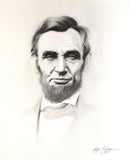Sitting Bull and Custer by Gary Saderup
Sitting Bull in Standard Lakota Orthography, also nicknamed "Slow"; c. 1831 – December 15, 1890) was a Hunkpapa Lakota holy man who led his people during years of resistance to United States government policies. He was killed by Indian agency police on the Standing Rock Indian Reservation during an attempt to arrest him, at a time when authorities feared that he would join the Ghost Dance movement.
Before the Battle of the Little Bighorn, Sitting Bull had a vision in which he saw many soldiers, "as thick as grasshoppers," falling upside down into the Lakota camp, which his people took as a foreshadowing of a major victory in which a large number of soldiers would be killed.
About three weeks later, the confederated Lakota tribes with the Northern Cheyenne defeated the 7th Cavalry under Lt. Col. George Armstrong Custer on June 25, 1876, annihilating Custer's battalion and seeming to bear out Sitting Bull's prophetic vision.
Sitting Bull's leadership inspired his people to a major victory. Months after their victory at the battle, Sitting Bull and his group left the United States for Wood Mountain, North-West Territories (now Saskatchewan), where he remained until 1881, at which time he and most of his band returned to US territory and surrendered to U.S. forces.
A small remnant of his band decided to stay at Wood Mountain.George Armstrong Custer(December 5, 1839 – June 25, 1876) was a United States Army officer and cavalry commander in the American Civil War and the American Indian Wars. Raised in Michigan and Ohio, Custer was admitted to West Point in 1857, where he graduated last in his class in 1861. With the outbreak of the Civil War, Custer was called to serve with the Union Army.
After the Civil War, Custer remained a major general in the United States Volunteers until they were mustered out in February 1866. He reverted to his permanent rank of captain and was appointed a lieutenant colonel in the 7th Cavalry Regiment in July 1866.
He was dispatched to the west in 1867 to fight in the American Indian Wars. On June 25, 1876, while leading the 7th Cavalry Regiment at the Battle of the Little Bighorn in Montana Territory against a coalition of Native American tribes, he and all of his detachment—which included two of his brothers—were killed. The battle is popularly known in American history as "Custer's Last Stand." Custer and his regiment were defeated so decisively at the Little Bighorn that it has overshadowed all of his prior achievements.







